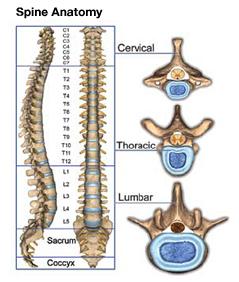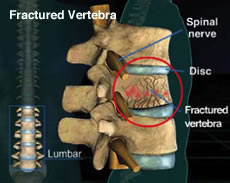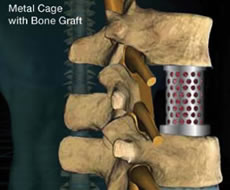Trauma
 Description
Description
Spinal trauma results from significant
physical injury sustained as a result of high
energy impacts or falls. Motor vehicle accidents
and common falls account for a large portion
of spinal trauma. These injuries can lead to
compression of one or more vertebrae.
Weakened bones (osteoporosis) can also lead
to fracture at a low level of trauma. A traumatic
episode can result in the sudden onset of
back pain.
Symptoms
- Back pain after an incident
- Weakness or numbness
- Paralysis
Causes
- High energy impact trauma
- Motor vehicle accident
- Falls
- Weakened bones (Osteoporosis)

Possible Treatment Options
Non Operative Treatment
Pain medications, patience, and bracing are sometimes needed.
Surgery may be considered for those who do not improve.
Lumbar Vertebral Body Replacement
If a vertebral body has been severely fractured in a traumatic
event, the entire vertebral body may be replaced with a stabilized
metal cage or bone strut. Instrumentation anchored to the
surrounding vertebral bodies stabilizes the construct.
Decompression
This surgical procedure involves removing all or a portion of
the lamina, removing bone spurs and/or enlarging the foramen
to relieve pressure on the nerve roots or spinal cord.
 Posterolateral Fusion
Posterolateral Fusion
Often times, in addition to a decompression, your surgeon will
perform an instrumented posterolateral fusion by inserting a
series of rods and screws coupled with the placement of bone
graft. This fusion provides increased spinal stability depending
on the severity of the injury.
For more information on Trauma, visit UnderstandSpineSurgery.com.
